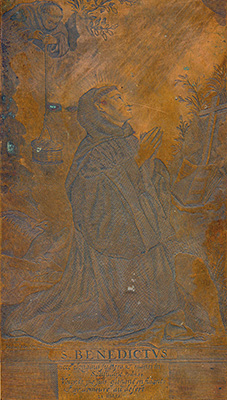The University Art Collection is a teaching collection, and as such it holds a number of original matrices of varying materials which have been incised by the artist, inked and then printed. Depending on the technique, whether carved into (intaglio) or drawn on the surface (planographic), matrices can be made from metal, wood, stone, or synthetic surfaces.
 By far the oldest in the collection is this intriguing copper plate engraving depicting Saint Benedict, possibly from the 17th century. The robed saint kneels in prayer, his eyes directed heavenward, in an outdoor setting before a book and crucifix. Behind him a monk in an opening above suspends a bucket from a rope and below that appears a bird with outstretched wings.
By far the oldest in the collection is this intriguing copper plate engraving depicting Saint Benedict, possibly from the 17th century. The robed saint kneels in prayer, his eyes directed heavenward, in an outdoor setting before a book and crucifix. Behind him a monk in an opening above suspends a bucket from a rope and below that appears a bird with outstretched wings.
Benedict of Nursia lived from 480 to circa 570 CE and established twelve monastic communities in the mountains of Subiaco in the Lazio region east of Rome. The primary one is the magnificent Benedictine monastery of Monte Cassino set on a rocky hillside. The sanctuary was severely damaged by Allied bombs during WWII and later rebuilt to remain a popular destination for visitors and clergy alike. Benedict is primarily recognized for the highly influential set of precepts known as “The Rule of Saint Benedict,” which set forth how monks should live and administer their communal monasteries. Written in seventy-three chapters, these rules helped the spread of monasticism in the west, thereby establishing civilization and culture throughout Europe in the Middle Ages and beyond. St. Benedict was canonized in 1220, and in 1964 was named a patron saint of Europe by Pope Paul VI (together with two others, Saints Cyril and Methodius).
Benedict dwelled for three years as a hermit in a mountainside cave. During his isolation he was fed by a monk named Romanus who lived in a monastery above the cave. The copper plate engraving shows a monk lowering food to Benedict via a bucket on a rope, and the bird below it may be a reference to the raven that miraculously saved Benedict when a jealous monk tried to poison him with tainted bread. To save Benedict from death, it is believed that God sent a raven to swoop down and remove the tainted loaf before Benedict could consume it.
The inscription below the image includes a quote from Psalm 54, which generally praises God as protector and sustainer of life. The date of March 21 inscribed below that is believed to be the date of Benedict's death resulting from a high fever. The feast day of St. Benedict is celebrated on two different dates in the Eastern Orthodox Church (March 14) and in the Anglican Church (July 11). The plate is signed in the lower left by one Michael Hayé, a French artist about whom little is known. We do not own a printed impression of this plate and are in hopes of finding more information about its context and history; whether it was created (most likely) as a plate for an illustrated volume, and if so in which volume the image might have appeared. If you have any information that might help in this regard, please get in touch with me!
--LuLen Walker, University Art Curator
June 8, 2017
